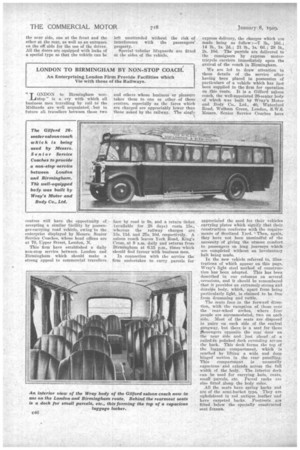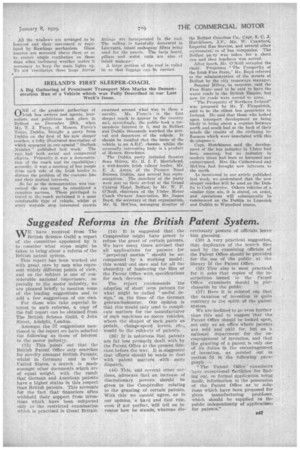LONDON TO BIRMINGHAM BY NON-STOP COACH.
Page 32

Page 33

If you've noticed an error in this article please click here to report it so we can fix it.
An Enterprising London Firm Provide Facilities Which Vie with those of the Railways.
" T ONDON to Birmingham non
IA stop " is a cry with which all business men travelling by rail to the Midlands are well acquainted; but in future all travellers between those two centres will have the opportunity 0 accepting a similar facility by passenger-carrying road vehicle, owing to the enterprise displayed by Messrs. Senior Service Coaches, whose head offices are at 70, Upper Street, Loudon, N.
This firm have established a daily non-stop service between London and Birmingham which should make a strong appeal to commercial travellers and others whose business or pleasure takes them to one or other of these centres, especially as the fares which are charged are appreciably lower than those asked by the railway. The single fare by road is Ps. and a return ticket (available for 28 (lays) costs 15s., whereas the railway charges are 13s. 11d. and 27s. 10d. respectively. A saloon coach leaves York Road, King's Cross, at 9 a.m. daily and returns from Birmingham at 6.15 p.m., times which shonld find favour with business men.
In connection with the service the firm undertakes to carry parcels for express delivery, the charges which are made being as follow :-7 lb., 10(1.; 14 lb., 1s. 2d.; 21 lb., 1s. 6d. ; 28 lb., 2s. 10d. The parcels are delivered to the consignees by express motortricycle carriers immediately upon the arrival of the coach in Birmingham.
We are led to draw attention to these details of the service after having been placed in possession of particulars of a vehicle which has just been supplied to the firm for operation on this route. It is a Gifford saloon coach, the well-appointed 26-seater body of which was built by Wray's Motor and Body Co.. Ltd., 40, Waterford Road, Walham Green, London, S.W.6. Messrs. Senior Service Coaches have
appreciated the need for their vehicles carrying plates which signifY that their construction conforms with the requirements of Scotland Yard.' Then, again, they have not been unmindful of rhe necessity of giving the utmost cGmfort to passengers on long journeys which are completed without an involuntary halt being made.
In the new vehicle referred to, illustrations of which appear on this page. Wray's light steel method of construction has been adopted. This has been described in our columns on several , occasions, and it should be remembered that it provides an extremely strong and durahle body, which, apart from being particularly light, is claimed to be free from drumming and rattle.
The seats face in the forward direction, with the exception of these over the rear-wheel arches, where four people are accommodated, two on each side. Most of the seats are disposed in pairs on each side of the central gangway, but there is a seat for three Passengers opposite the rear door on the near side and just ahead of a railed-in polished deck extending acr,ms the back. This deck forms the top of the luggage compartment, which is reached by lifting a wide and deep hinged section in the rear. panelling. This compartment is unusually capacious and extends across the full width of the body. The interior deck can be used for carrying hats, coats, small parcels, etc. Parcel racks are also fitted along the body sides.
All the seats have spring backs and are of the semirbucket type. They are upholstered in red, antique leather and have carpeted backs. Footrests are fitted below the specially constructed seat frames.
All the winaoWs are areang,ed to be lowered and their movement is regtilated by Rawlings mechanism. Glass louvres are mounted above them so as to ensure ample ventilation on those days when inclement weather makes it necessary to keep the main. lights up. To aid ventilation three large Airvac fittings are incorporated in the roof. The ceiling is tastefully decorated in Lincrusta, inlaid mahogany fillets being used for the panels. The facia board, pillars and waist rails are also of inlaid •mahoetv
A large portion of the roof is railed in so that luggage can be carried.




































